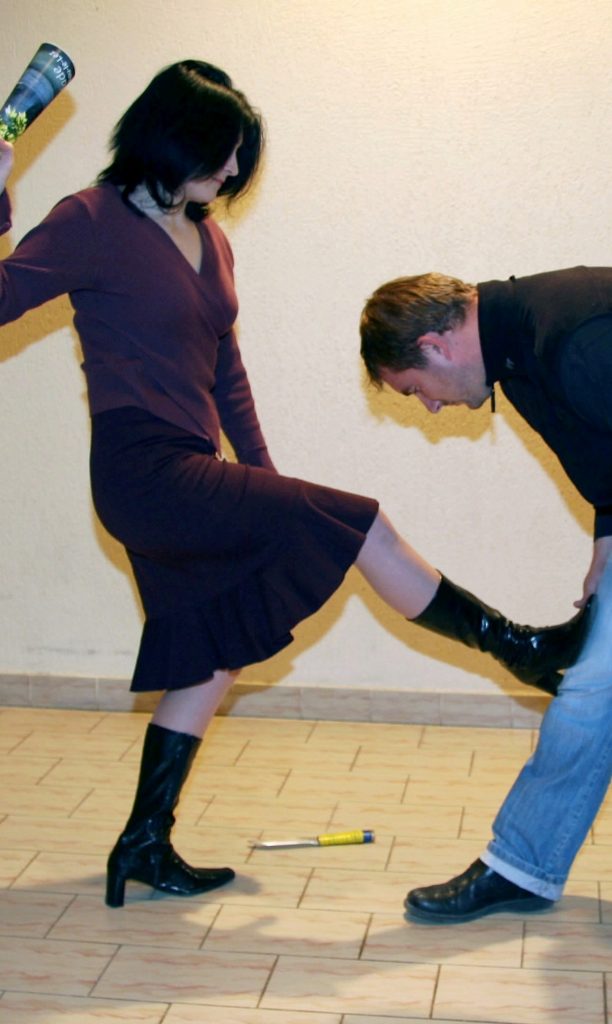
The 4 depicted in the Fit4Defense logo represents four A’s – Attention, Awareness, Avoidance and Action. These concepts are crucial to building confidence and self esteem.
Self esteem includes a realistic self awareness of the problems we face and a belief that we have the means to solve them. It requires self acceptance, to feel good about ourselves just as we are. In order to do this, we need to feel competent, connected to others, yet independent. For this reason the focus of the Fit4Defense curriculum and the PowerEd classes is on rights, boundaries, values, strengths, feelings and communication. The goal is that participants will gain insight into their strengths, unique qualities and their ability to positively impact others which will lead to a greater acceptance of self. The objective of imparting self-awareness/self-defense seeks to permanently change attitudes, behaviours, and awareness, preventing the likelihood of victimization and crime.
The following are the strategies that we teach and encourage our participants to follow during their day-to-day lives.
Attention

- Carefully observe the people and things in your surroundings. Conduct a 360 visual sweep.
- Have a working cell phone with you if possible.
- Avoid situations where you do not know anyone.
- Do not drink to excess – you become less able to defend yourself.
- Keep your drink with you at a party or bar, it could be tampered with.
- Make sure your home is safe with good door and window locks and well-lit entrances.
- Make sure someone knows where you are.
Awareness

- Trust your intuition and feelings.
- Share your feelings with someone else if you are uncomfortable with someone.
- If you feel unsafe about entering someone’s home, DON’T!
- Understand who you are and communicate what you believe, feel, want, and need with confidence
- Accept love and trust your yourself
- Be kind and care for others
Avoidance

- If you feel your safety is at risk, learn strategies for leaving and or managing a potentially aggressive or dangerous situation, by taking a PowerEd course.
- Plan your routes; look around when on the streets and before getting into your car.
- ALWAYS keep an emergency exit route in mind; do not allow yourself to be cornered. Try to situate yourself between the exit and an aggressive person. If at any time you feel unsafe, firmly and politely excuse yourself and leave the area.
- ANTICIPATE any possible dangers for yourself or others.
- THINK AHEAD
Action

- If you are bullied, get help from a trusted friend or adult immediately
- Stand up! Standing can make you more mobile for a quick escape. Keep hands free.
- Take verbal threats seriously.
- If possible, move away from the person so that there is about 6 feet between you. At this distance, it will be more difficult to hit you.
- Stand facing the aggressive person with your feet slight apart and step back to protect your centerline and vital points. You may want to stand on the balls of your feet for faster maneuvering and/or a quick escape.
- Keep your arms at your sides with your palms up. This is less threatening. Never clench your fists or put your hands in your pocket or behind your back.
- Stay calm! Breathe! You may be able to de-escalate a person with calm, reassuring tones. You also do not want to appear frightened or intimidated.
- Don’t respond with an argument. Be polite but firm, calm and confident; speak slowly, using simple precise words.
- Let the person know you are listening; restate your position calmly using ‘I’ statements. Examples: “I need to leave now.” “I need for you to calm down so that we can discuss this.” “I want to understand your point of view.”
- Watch the person’s body language, including shaking or clenching fists, or a change in posture. Changes may indicate that the person is ready to do something physical.
- Combine all of your strength with a strong will to succeed.
- Use the spirit shout for energy and confidence.
- Don’t stop fighting until the confrontation is over.
- Keep thinking, make a plan, and never give up!
- Seek help, yelling FIRE, STAY AWAY FROM ME, STOP to get the attention of others.
- Run, escape or defend yourself using simple techniques, this is a last resort!


